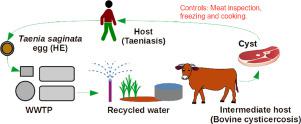Microbial Risk Analysis ( IF 2.8 ) Pub Date : 2021-03-30 , DOI: 10.1016/j.mran.2021.100164 Daryl Stevens , Aravind Surapaneni , Dan Deere , Nick O'Connor , Nick Crosbie , Alex Keegan , Leon Stackpole , Martin Robards

|
The probability of cysticercus bovis (CB) infection of cattle (cysticerci from Taenia saginata) in a country where T. saginata is not endemic (i.e. Australia) was assessed using a Quantitative Microbial Risk Assessment (QMRA) approach. Two important features of the QMRA were (i) a dose-response curve to describe ingestion of eggs of the helminth T. saginata (HE) by cattle and the development of cysticerci due to the infection, and (ii) characterisation of HE concentrations. Data limitations relating to HE quantification are described, and several other key variables provided the basis for a probabilistic QMRA model.
Data from over 554 sewage samples from 11 wastewater treatment plants (WWTPs) in Southern Australia indicated the background concentration of T. saginata eggs was low (<0.1 HE L-1 measured, 0.003 HE L-1 as an estimated baseline modelled on a ratio of Taenia:Ascaris determined from the literature). Such a low sewage concentration was estimated to require only a 2.2 log10 reduction value (LRV) via sewage treatment to maintain the baseline risk of CB equivalent to background levels in Australia. However, to protect against potential future detectable outbreaks of Taeniasis in the human population and all potential exposure scenarios considered, a 3.5 LRV for WWTP was considered appropriate with confirmation by appropriate sewage monitoring. In addition, analysis of several specific exposure scenarios using the QMRA indicated that LRV credits (0.5 to 2.0 LRV) could decrease the required LRV for wastewater treatment based on the size of the WWTP and on-site management strategies (e.g. restriction of recycled water use for livestock drinking water, the years of exposure for cattle to sites irrigated with recycled water, and the use of fodder off-site). Without such measures, a HE LRV of 4.0 is recommend for WWTPs to ensure adequate protection of systems with no on-site controls.
中文翻译:

在非流行国家因接触循环水而在牲畜中检测到牛囊尾蚴的概率
的牛囊尾蚴(CB)的牛感染(从囊尾蚴的概率牛带绦虫)在一个国家里绦虫是不是流行(如澳大利亚)用微生物定量风险评估(QMRA)的方法进行评估。QMRA 的两个重要特征是 (i) 描述牛摄入蠕虫T. saginata (HE)卵和由于感染引起的囊尾蚴发育的剂量反应曲线,以及 (ii) HE 浓度的表征。描述了与 HE 量化相关的数据限制,并且其他几个关键变量为概率 QMRA 模型提供了基础。
数据从南澳大利亚11的废水处理厂(污水处理厂)超过554污水样品表示的背景浓度绦虫卵低(<0.1 HE大号-1测量,0.003 HE大号-1作为仿照比的估计基准的带绦虫:蛔虫从文献确定)。如此低的污水浓度估计只需要 2.2 log 10通过污水处理减少值 (LRV),以保持与澳大利亚背景水平相当的 CB 基线风险。然而,为了防止未来可检测到的人群中潜在的绦虫病爆发和所有考虑的潜在暴露情况,污水处理厂的 3.5 LRV 被认为是合适的,并通过适当的污水监测进行确认。此外,使用 QMRA 对几个特定暴露场景的分析表明,LRV 信用(0.5 到 2.0 LRV)可以根据污水处理厂的规模和现场管理策略(例如限制循环水的使用)降低废水处理所需的 LRV家畜饮用水、牛暴露于循环水灌溉场所的年数以及场外饲料的使用)。如果没有这些措施,HE LRV 为 4。



























 京公网安备 11010802027423号
京公网安备 11010802027423号